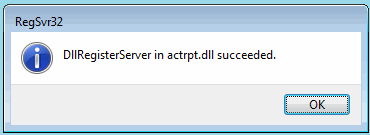

- #REGISTER A DLL FILE IN VISTA INSTALL#
- #REGISTER A DLL FILE IN VISTA SOFTWARE#
- #REGISTER A DLL FILE IN VISTA CODE#
- #REGISTER A DLL FILE IN VISTA WINDOWS#
Application installers are typically executed in a privileged security context that has access to install DLLs into the system directories and to edit the system registry to register new DLLs as COM objects.Consequently, third-party developers also distributed these in such a manner.

#REGISTER A DLL FILE IN VISTA CODE#
#REGISTER A DLL FILE IN VISTA WINDOWS#
Early examples of this were the ctl3d.dll and ctl3dv2.dll libraries for Windows 3.1: Microsoft-created libraries that third-party publishers would distribute with their software, but each distributing the version they developed with rather than the most recent version. As a result, an installation of a program that installed a new version of a common object might inadvertently break other programs that were previously installed.Ī common and troublesome problem occurs when a newly installed program overwrites a working system DLL with an earlier, incompatible version. If any program needed to create an instance of that class, it got whatever was the current centrally registered implementation. Only one COM object in one DLL/EXE could be declared as having a specific global COM Class ID on a system. Before Windows 2000, Windows was vulnerable to this because the COM class table was shared across all users and processes. A bug fix for one application may result in the removal of a feature from another. This is insufficient, however, because the semantics of a class can change. Object Linking and Embedding has very strict rules to prevent this: interfaces are required to be stable, and memory managers are not shared. C++ classes export many methods, and a single change to the class, such as a new virtual method, can make it incompatible with programs that were built against an earlier version. Windows has been particularly vulnerable to this because of its emphasis on dynamic linking of C++ libraries and Object Linking and Embedding (OLE) objects.

NET replacement, "Assemblies".Ī particular version of a library can be compatible with some programs that use it and incompatible with others. Solutions to these problems were known even while Microsoft was writing the DLL system. The difficulties include conflicts between DLL versions, difficulty in obtaining required DLLs, and having many unnecessary DLL copies. There are several problems commonly encountered with DLLs, especially after numerous applications have been installed and uninstalled on a system. Even minor changes to the DLL code can cause this directory to be re-arranged, in which case an application that calls a particular method believing it to be the 4th item in the directory might end up calling an entirely different and incompatible routine, which would normally cause the application to crash. The file contains a directory of the individual methods (procedures, routines, etc.) contained within the DLL and the types of data they take and return. Static libraries avoid this problem because the version that was used to build the application is included inside it, so even if a newer version exists elsewhere on the system, this does not affect the application.Ī key reason for the version incompatibility is the structure of the DLL file. DLLs have no built-in mechanism for backward compatibility, and even minor changes to the DLL render its internal structure so different from previous versions that attempting to use them will generally cause the application to crash. The problem arises when the version of the DLL on the computer is different than the version that was used when the program was being created. In this case, every application grows by the size of all the libraries it uses, and this can be quite large for modern programs. This contrasts with static libraries, which are functionally similar but copy the code directly into the application. By placing this code in a DLL, all the applications on the system can use it without using more memory. A simple example might be the GUI text editor, which is widely used by many programs.

#REGISTER A DLL FILE IN VISTA SOFTWARE#
Shared libraries allow common code to be bundled into a wrapper, the DLL, and used by any application software on the system without loading multiple copies into memory.


 0 kommentar(er)
0 kommentar(er)
